Last updated: January 23, 2025
Article
The Washington Monument: Tribute in Stone (Teaching with Historic Places)
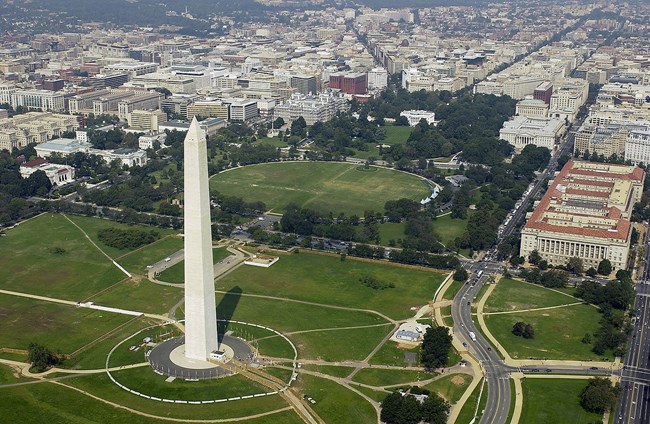
CC0
This lesson is part of the National Park Service’s Teaching with Historic Places (TwHP) program.
It rises tall and brilliant, its whiteness emphasized by the green grass and colorful flags that surround it. It stands at the heart of Washington, D.C., near the center of a cross formed by four of America's most famous buildings: the U.S. Capitol and the Lincoln Memorial, the White House and the Jefferson Memorial.
But appearance and location are not the only reasons that the Washington Monument is one of the country's most recognizable structures. Its prominence comes also because it commemorates George Washington, who remains one of the country's most admired leaders more than two centuries after his death. The history of the monument reflects his contributions to the development of the United States and shows how Americans have debated the best way to honor important citizens.
About This Lesson
This lesson is based on the National Register of Historic Places registration file "Washington Monument" (with photographs), and the visitor's guide to the Monument, and other source material about George Washington and the structure built to honor him. It was written by Stephanie A. Kopin, park ranger at the National Mall. TwHP is sponsored, in part, by the Cultural Resources Training Initiative and Parks as Classrooms programs of the National Park Service. This lesson is one in a series that brings the important stories of historic places into the classrooms across the country.
Where it fits into the curriculum
Topics: This lesson could be used in teaching units on the American Revolution and the early Federal period as the focus for a discussion of whether Washington deserved the reverence he inspired. It could be part of units on the formation of national identity, collective memory, and interpretations of the past. It could also be used in units on art history, architecture, or urban planning.
Time period: 1760s-1880s
United States History Standards for Grades 5-12
The Washington Monument: Tribute in Stone relates to the following National Standards for History:
Era 3: Revolution and the New Nation (1754-1820s)
-
Standard 1C- The student understands the factors affecting the course of the war and contributing to the American victory.
-
Standard 2A- The student understands revolutionary government-making at national and state levels.
-
Standard 3A- The student understands the issues involved in the creation and ratification of the United States Constitution and the new government it established.Era 4: Expansion and Reform (1801-1861)
-
Standard 2C-The student understands how antebellum immigration changed American society.Era 6: The Development of the Industrial United States (1870-1900)
-
Standard 2C- The student understands how new cultural movements at different social levels affected American life.
Curriculum Standards for Social Studies
(National Council for the Social Studies)
The Washington Monument: Tribute in Stone relates to the following Social Studies Standards:
Theme II: Time, Continuity and Change
-
Standard D - The student identifies and uses processes important to reconstructing and reinterpreting the past, such as using a variety of sources, providing, validating, and weighing evidence for claims, checking credibility of sources, and searching for causality.
-
Standard F - The student uses knowledge of facts and concepts drawn from history, along with methods of historical inquiry, to inform decision-making about and action-taking on public issues.Theme III: People, Places, and Environment
-
Standard G - The student describes how people create places that reflect cultural values and ideals as they build neighborhoods, parks, shopping centers, and the like.Theme IV: Individual Development and Identity
-
Standard F - The student identifies and describes the influence of perception, attitudes, values, and beliefs on personal identity.Theme V: Individuals, Groups, and Institutions
-
Standard B - The student analyzes groups and institutional influences on people, events, and elements of culture.
-
Standard G - The student applies knowledge of how groups and institutions work to meet individual needs and promote the common good.Theme IV: Individual Development and Identity
-
Standard F - The student identifies and describes the influence of perception, attitudes, values, and beliefs on personal identity.Theme X: Civic Ideals, and Practices
-
Standard A - The student examines the origins and continuing influence of key ideals of the democratic republican form of government, such as individual human dignity, liberty, justice, equality, and the rule of law.
-
Standard D - The student practices forms of civic discussion and participation consistent with the ideals of citizens in a democratic republic.
-
Standard E - The student explains and analyzes various forms of citizen action that influence public policy decisions.
-
Standard I - The student explains the relationship between policy statements and action plans used to address issues of public concern.
-
Standard J - The student examines strategies designed to strengthen the "common good," which consider a range of options for citizen action.
Objectives for students
1) To understand some of the reasons Washington was so revered during the early 19th century.
2) To describe the intentions behind the memorial to George Washington.
3) To analyze how ideas about the best designs for a monument change over time.
4) To investigate memorials found in their community.
Materials for students
The materials listed below either can be used directly on the computer or can be printed out, photocopied, and distributed to students. The maps and images appear twice: in a low-resolution version with associated questions and alone in a larger, high-resolution version.
1) a map showing L'Enfant's original plan for Washington, D.C.
2) three readings about the attempts to build the monument;
3) a broadside encouraging Americans to contribute to the building of the monument;
4) six drawings of potential designs for the monument
5) one cartoon about the monument;
6) one photograph of the Washington Monument today.
Visiting the Site
The Washington Monument, administered by the National Park Service, is located in Washington, D.C., on the National Mall between 15th and 17th Streets and between Constitution and Independence Avenues. It is open to the public every day except December 25. For more information, visit the park web pages.
Getting Started
Inquiry Question
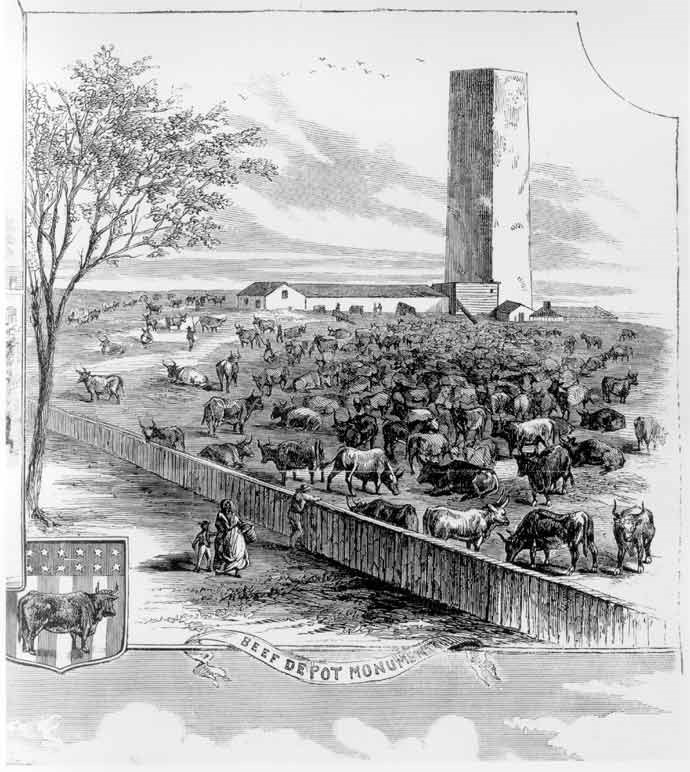
To which U.S. monument do you think the cartoon refers?
Setting the Stage
George Washington (1732-1799) became involved in military and political affairs long before most American colonists considered breaking away from Britain. In 1754, for example, Virginia's governor sent the 21-year-old Washington to the Ohio Valley to warn the French to stay out of lands claimed by Great Britain; the ensuing French and Indian War provided him valuable military experience. In subsequent years he gained election to Virginia's colonial assembly and became a justice in his county's court system.
In 1774 Washington was one of Virginia's representatives to the First Continental Congress in Philadelphia. The following year delegates to the Second Continental Congress chose him to lead the newly-created Continental Army. Twenty years had passed since he had commanded troops, but he was a man of upright character, favored moderate politics, and could be counted on to secure Virginia's support for a fight whose main advocates were concentrated in New England. Washington led this army to victory over the British, then retired to his plantation. He reentered public life in 1787, when he agreed to preside over the convention called to find solutions to the problems that existed under the Articles of Confederation. The Constitution that emerged from that summer in Philadelphia established the office of President, and Washington was the obvious choice to fill the position.
Locating the Site
Map 1: The L'Enfant Plan for Washington.
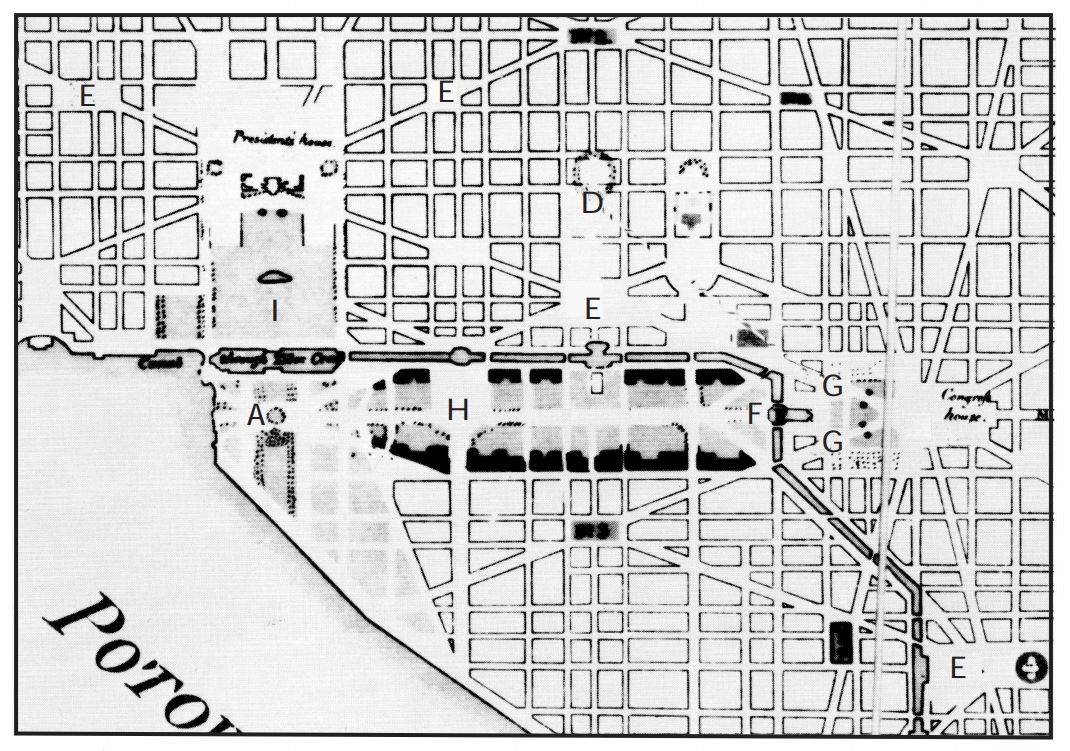
In the years following the Declaration of Independence, the United States moved its capital often. In 1790 Congress decided to locate the Federal Government permanently on land that straddled the Potomac River just upstream from George Washington's plantation at Mount Vernon, Virginia. Over the next year Pierre L'Enfant, a French engineer who had served in the American Army, laid out the city that would be called Washington, District of Columbia.
Along the margins of his map was a key, excerpts from which appear below:
-
-
A. THE equestrian figure of GEORGE WASHINGTON, a monument voted in 1783, by the late Continental Congress.
-
B. An historic Column. Also intended for a Mile or itinerary column, from whose station (a mile from the Federal house) all distances of place through the Continent, are to be measured. [not visible on Map 1]
-
C. A Naval itinerary Column, proposed to be erected to celebrate the first rise of a Navy and to stand as a ready monument to consecrate its progress and achievements. [not visible on Map 1]
-
D. This Church is intended for national purposes, such as public prayer, thanksgivings, funeral orations &c. and assigned to the special use of no particular Sect or denomination.
-
E. Five grand fountains, intended with a constant spout of water.
-
F. Grand Cascade, formed of the water from the sources of the Tiber.
-
G. Public walk, being a square of 1200 feet, through which carriages may ascend to the upper square of the Federal house.
-
H. Grand Avenue, 400 feet in breadth, and about a mile in length, bordered with gardens, ending in a slope from the houses on each side. This Avenue leads to the monument A, and connects the Congress garden with
-
I. Presidents' Park.
Questions for Map 1
1. After what two men was the capital named? Why do you think Congress chose to recognize those two?
2. What does the letter "A" represent on the L'Enfant plan?
3. What other buildings were to be located near "A"?
4. Why do you think L'Enfant placed the memorial where he did?
Determining the Facts
Reading 1: Washington and the Early Republic
When the Revolutionary War ended, no man in the United States commanded more respect than George Washington. Americans celebrated his ability to win the war despite limited supplies and inexperienced men, and they admired his decision to refuse a salary and accept only reimbursements for his expenses. Their regard increased further when it became known that he had rejected a proposal by some of his soldiers to make him king of the new country. It was not only what Washington did but the way he did it: Abigail Adams, wife of John Adams, described him as "polite with dignity, affable without familiarity, distant without haughtiness, grave without austerity, modest, wise, and good."
Washington retired to his plantation at Mount Vernon after the war, but he soon had to decide whether to return to public life. As it became clear that the Articles of Confederation had left the Federal Government too weak to levy taxes, regulate trade, or control its borders, men such as James Madison began calling for a convention that would strengthen its authority. Washington was reluctant to attend, as he had business affairs to manage at Mount Vernon. If he did not go to Philadelphia, however, he worried about his reputation and about the future of the country. He finally decided that, since "to see this nation happy...is so much the wish of my soul," he would serve as one of Virginia's representatives. The other delegates during the summer of 1787 chose him to preside over their deliberations, which ultimately produced the U.S. Constitution.
A key part of the Constitution was the development of the office of President. No one seemed more qualified to fill that position than Washington, and in 1789 began the first of his two terms. He used the nation's respect for him to develop respect for this new office, but he simultaneously tried to quiet fears that the President would become as powerful as the king the new country had fought against. He tried to create the kind of solid government he thought the nation needed, supporting a national bank, collecting taxes to pay for expenses, and strengthening the Army and Navy. Though many people wanted him to stay for a third term, in 1797 he again retired to Mount Vernon.
Washington died suddenly two years later. His death produced great sadness, and it restarted attempts to honor him. As early as 1783, the Continental Congress had resolved "That an equestrian statue of George Washington be erected at the place where the residence of Congress shall be established." The proposal called for engraving on the statue that explained that it had been erected "in honor of George Washington, the illustrious Commander-in-Chief of the Armies of the United States of American during the war which vindicated and secured their liberty, sovereignty, and liberty." Though it was easy to understand why nothing happened while the government lacked a permanent home, there was little progress even after Congress had settled on Washington, D.C. as the new capital.
Ten days after President Washington's death, a Congressional committee recommended a different type of monument. John Marshall, a Representative from Virginia who would soon become Chief Justice of the Supreme Court, proposed that a tomb be erected within the Capitol. But a lack of funds, disagreement over what type of memorial would best honor the country's first president, and the Washington family's reluctance to move his body prevented progress on any project. That inaction would prove typical in the coming years.
Questions for Reading 1
1. Why did so many Americans revere George Washington?
2. Which proposed monument, the equestrian statue or the tomb, do you think would have been the more appropriate way to honor Washington? Why?
3. In general, do you think it is a good idea to build monuments to people who are still live? Why or why not?
Reading 1 was compiled from History of the Washington Monument and Washington National Monument Society, complied by Frederick L. Harvey, Secretary, Washington National Monument Society (Washington, D.C.: Government Printing Office, 1903).
Determining the Facts
Document 1: Samuel Blodgett's Broadside, 1801.
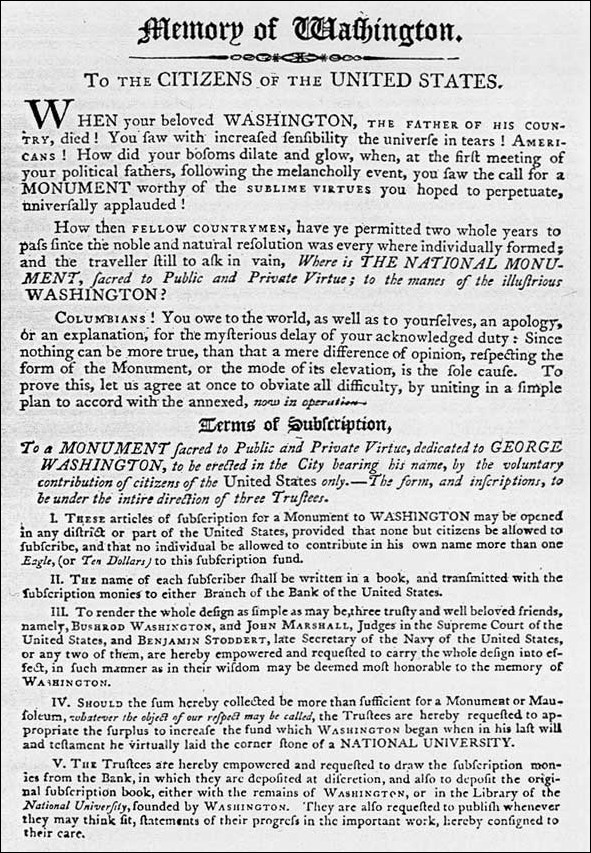
National Archives
Disagreements over a proper memorial to Washington continued for the first three decades of the 19th century, with nothing built during this time. Samuel Blodgett published this broadside--a flyer meant to move people to action--at the beginning of that period. It records many of the arguments that would appear over those 30 years.
Transcript: Samuel Blodgett's Broadside, 1801.
Memory of Washington.
To the CITIZENS of the UNITED STATES.
WHEN your beloved WASHINGTON, THE FATHER OF HIS COUNTRY, died! You saw with increased sensibility the universe in tears! AMERICANS! How did your bosoms dilate and glow, when at the first meeting of your political fathers, following the melancholly event you saw the call for a MONUMENT worthy of the SUBLIME VIRTUES you hoped to perpetuate, universally applauded!
How then FELLOW COUNTRYMEN, have ye permitted two whole years to pass since the noble and natural resolution was every where individually formed; and the traveller still to ask in vain, Where is THE NATIONAL MONUMENT, sacred to Public and Private Virtue; to the manes of the illustrious WASHINGTON?
Columbians! You owe to the world, as well as to yourselves, an apology or an explanation, for the mysterious delay of your acknowledged duty: Since nothing can be more true, than that a mere difference of opinion, respecting the form of the Monument, or the mode of its elevation, is the sole cause. To prove this, let us agree at once to obviate all difficulty, by uniting in a simple plan to accord with the annexed, now in operation.
Terms of Subscription,
To a MONUMENT sacred to Public and Private Virtue, dedicated to GEORGE WASHINGTON, to be erected in the City bearing his name, by the voluntary contribution of citizens of the United States only.--The form, and inscriptions, to be under the intire direction of three Trustees.
I. THESE articles of subscription for a Monument to WASHINGTON may be opened in any district or part of the United States, provided that none but citizens be allowed to subscribe, and that no individual be allowed to contribute in his own name more than one Eagle, (or Ten Dollars) to this subscription fund.
II. THE name of each subscriber shall be written in a book, and transmitted with the subscription monies to either Branch of the Bank of the United States.
III. TO render the whole design as simple as may be, three trusty and well beloved friends, namely, BUSHROD WASHINGTON, and JOHN MARSHALL, Judges in the Supreme Court of the United States, and BENJAMIN STODDERT, late Secretary of the Navy of the United States, or any two of them, are hereby empowered and requested to carry the whole design into effect, in such manner as in their wisdom may be deemed most honorable to the memory of WASHINGTON.
IV. SHOULD the sum hereby collected be more than sufficient for a Monument or Mausolleum, whatever the object of our respect may be called, the Trustees are hereby requested to appropriate the surplus to increase the fund which WASHINGTON began when in his last will and testament he virtually laid the corner stone of a NATIONAL UNIVERSITY.
V. THE Trustees are hereby empowered and requested to draw the subscription monies from the Bank, in which they are deposited at discretion, and also to deposit the original subscription book, either with the remains of WASHINGTON, or in the Library of the National University, founded by WASHINGTON. They are also requested to publish whenever they may think fit, statements of their progress in the important work, hereby consigned to their care.
Determining the Facts
Reading 2: Construction of the Monument
Progress towards a memorial finally began in 1833. That year, which marked the 100th anniversary of Washington's birth, a large group of concerned citizens formed the Washington National Monument Society. They began collecting donations, much in the way Blodgett had suggested. By the middle of the 1830s, they had raised over $28,000 and announced a competition for the design of the memorial.
On September 23, 1835, the board of managers of the Society described their expectations:
It is proposed that the contemplated monument shall be like him in whose honor it is to be constructed, unparalleled in the world, and commensurate with the gratitude, liberality, and patriotism of the people by whom it is to be erected....[It] should blend stupendousness with elegance, and be of such magnitude and beauty as to be an object of pride to the American people, and of admiration to all who see it. Its material is intended to be wholly American, and to be of marble and granite brought from each state, that each state may participate in the glory of contributing material as well as in funds to its construction.
The Society held a competition for designs in 1836. The winner, architect Robert Mills, was well-qualified for the commission. In 1814 the citizens of Baltimore had chosen him to build a monument to Washington, and he had designed a tall Greek column surmounted by a statue of the President. Mills also knew the capital well, having just been chosen Architect of Public Buildings for Washington.
His design called for a 600' tall obelisk--an upright, four-sided pillar that tapers as it rises--with a nearly flat top. He surrounded the obelisk with a circular colonnade, the top of which would feature Washington standing in a chariot. Inside the colonnade would be statues of 30 prominent Revolutionary War heroes.
Yet criticism of Mills's design and its estimated price tag of more than $1 million caused the Society to hesitate. In 1848 its members decided to start building the obelisk and to leave the question of the colonnade for later. They believed that if they used the $87,000 they had already collected to start work, the appearance of the Monument would spur further donations that would allow them to complete the project.
About this time Congress donated 37 acres of land for the project. The spot L'Enfant had chosen was swampy and unstable, making it unsuitable for supporting what would be an enormously heavy structure. The new location was slightly south and east of the original but still offered many advantages. It "presents a beautiful view of the Potomac," wrote a member of the Society, and "is so elevated that the monument will be seen from all parts of the surrounding country." Because it is public land, he continued, "it is safe from any future obstruction of the view...[and it] would be in full view of Mount Vernon, where rests the ashes of the chief."
Excavation for the foundation of the Washington Monument began in the spring of 1848. The cornerstone was laid as part of an elaborate Fourth of July ceremony hosted by the Freemasons, a world-wide fraternal organization that Washington belonged to and that still exists today. Speeches that day showed that the country continued to revere Washington: one celebrant noted that "No more Washingtons shall come in our time...But his virtues are stamped on the heart of mankind. He who is great in the battlefield looks upward to the generalship of Washington. He who grows wise in counsel feels that he is imitating Washington. He who can resign power against the wishes of a people, has in his eye the bright example of Washington."
Construction continued until 1854, when donations ran out. The next year Congress voted to appropriate $200,000 to continue the work, but it changed its mind before the money could be spent. This reversal came because of a new policy the Society had adopted in 1849. It had agreed, after a request from some Alabamians, to encourage all states and territories to donate memorial stones that could be fitted into the interior walls. Members of the Society believed this practice would make citizens feel they had a part in building the Monument, and it would cut costs by limiting the amount of stone that had to be bought.
Blocks of marble, granite, and sandstone steadily appeared at the site. American Indian tribes, professional organizations, societies, businesses, and foreign nations donated stones that were four feet long, two feet high, and 12 to 18 inches thick. Many, however, carried inscriptions irrelevant to a memorial for George Washington. For example, one from the Templars of Honor and Temperance stated "We will not buy, sell, or use as a beverage, any spiritous or malt liquors, Wine, Cider, or any other Alcoholic Liquor."
It was just one memorial stone that started the events that stopped the Congressional appropriation and ultimately construction altogether. In the early 1850s, Pope Puis IX contributed a block of marble. In March 1854, members of the anti-Catholic, anti-immigrant American Party--better known as the "Know-Nothings"--stole the Pope's stone as a protest and supposedly threw it into the Potomac. Then, in order to make sure the Monument fit their definition of "American," the Know-Nothings conducted a fraudulent election so they could take over the entire Society.
Congress immediately rescinded its $200,000 contribution. The Know-Nothings retained control of the Society until 1858, adding 13 courses of the masonry to the Monument—all of which was of such poor quality that it was later removed. Unable to collect enough money to finish work, they increasingly lost public support. The Know-Nothings eventually gave up and returned all records to the original Society, but the stoppage in construction continued into, then after, the Civil War.
Questions for Reading 2
1. As the Washington National Monument Society saw it, what should the Monument's design show?
2. Do you think the statement made at the cornerstone-laying ceremony accurately reflected Washington's importance? Why or why not?
3. Should the Commission have encouraged the states to contribute stones? Why or why not?
4. What event caused Congress to rescind the $200,000 it appropriated for construction? Do you agree with its decision to take back the money? Why or why not?
Reading 2 was complied from Report no. 485, House of Representatives, 43d Congress, 1st Sess., and from Louis D. Torres, The United States Army Corps of Engineers and the Construction of the Washington Monument (Washington, D.C.: Historical Division, Office of Administrative Services, Office of the Chief of Engineers, 1984).
Determining the Facts
Reading 3: Finishing the Monument
Interest in the Monument grew after the Civil War ended. Engineers studied the foundation several times to see whether it remained strong enough. In 1876, the Centennial of the Declaration of Independence, Congress agreed to appropriate another $200,000 to resume construction. The Monument, which had stood for nearly 20 years at less than one-third of its proposed height, now seemed ready for completion.
Before work could begin again, however, arguments about the most appropriate design resumed. Many people thought that a simple obelisk, one without the colonnade, would be too bare. Architect Mills was reputed to have said that omitting the colonnade would make the monument look like "a stalk of asparagus;" another critic said it offered "little...to be proud of."
This attitude led people to submit alternative designs. Both the Washington National Monument Society and Congress held discussions about how the Monument should be finished. The society considered five new designs, concluding that the one by William Wetmore Story (see Visual Evidence, Drawing 3) seemed "vastly superior in artistic taste and beauty." Congress deliberated over those five as well as Mills's original; while it was deciding, it ordered work on the obelisk to continue. Finally, the members of the Society agreed to abandon the colonnade and alter the obelisk so it conformed to classical Egyptian proportions.
Construction resumed in 1879 under the direction of Lieutenant Colonel Thomas L. Casey of the U.S. Army Corps of Engineers. Casey redesigned the foundation, strengthening it so it could support a structure that would ultimately weigh more than 40,000 tons. He then followed the society's orders and figured out what to do with the memorial stones that had accumulated. Though many people ridiculed them, Casey managed to install all 193 stones in the interior walls.
The building of the Monument proceeded quickly now that Congress had provided sufficient funding. In four years it was finally completed, with the 3,300-pound marble capstone being put in place on December 6, 1884, during another elaborate dedication ceremony. The completed monument stands 555' 5-1/8" tall, with exterior walls of white marble from Maryland and the interior ones lined with Maine granite.
The Washington Monument drew enormous crowds even before it opened officially. During the six months that followed its dedication, 10,041 people climbed the 893 steps to the top. After the elevator that had been used to raise building materials was altered so that it could carry passengers, the number of visitors grew rapidly. As early as 1888 an average of 55,000 people a month went to the top, and today the Washington Monument has more than 800,000 visitors each year.
Questions for Reading 3
1. Do you think the remaining memorial stones should have been included? Why or why not?
2. Other monuments, such as the Lincoln and Jefferson Memorials, include a large representation of the figure they honor. Would the Washington Monument have been more appropriate if it was clearer who it commemorated?
Reading 3 was compiled from the visitor's guide, "Washington Monument," (Washington, D.C.: National Park Service); materials from the Washington National Monument Society; and Louis Torres, The United States Army Corps of Engineers and the Construction of the Washington Monument (Washington, D.C.: Historical Division, Office of Administrative Services, Office of the Chief of Engineers, 1984).
Visual Evidence
Drawing 1: Robert Mills's design for the Washington Monument.

Library of Congress.
Photo 1: The Washington Monument today.
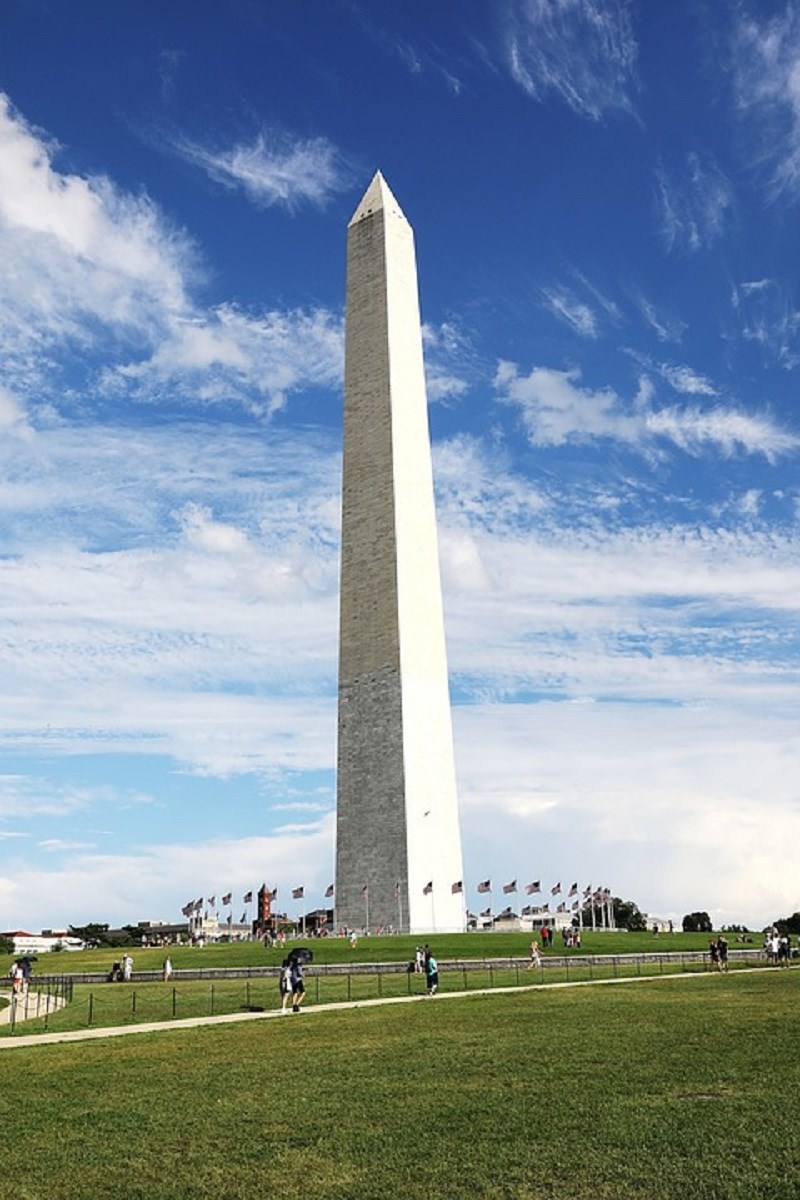
The design of the Washington Monument changed over time, and so the completed memorial has a very different appearance from what Robert Mills intended.
Questions for Drawing 1 and Photo 1
1. What ornate features did the original design include? What purpose do you think they would serve?
2. Is the monument built merely a copy of the first with the pantheon removed, or were other changes made to the obelisk? Why do you think as you do?
3. Does the resulting design still convey the Washington National Monument Society's original intentions (see Reading 2)? Which version do you think better represents the qualities that made George Washington so important?
4. Do you agree or disagree with Robert Mills's comment that the Monument would look like a stalk of asparagus without the Pantheon? Why?
Visual Evidence
Cartoon 1: The Washington Monument during the Civil War.

Library of Congress.
This 1862 cartoon comes from Leslie's Illustrated Newspaper, which had a large circulation during the 19th century.
Questions for Cartoon 1
1. Why would the site have been used as a cattle pen?
2. Why do you think the cartoonist used the title "Beef Depot Monument"?
3. Why do you think the newspaper included this image and this title?
Visual Evidence
Drawing 2: Alternative designs for the Washington Monument.
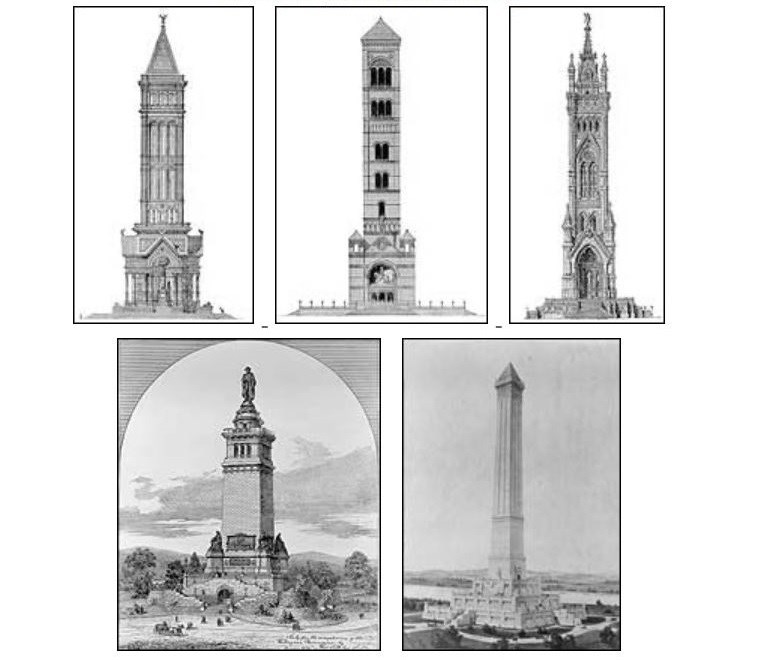
Library of Congress.
Each of these drawings was submitted after the Civil War, as the Washington National Monument Society and Congress debated how to complete the Monument.
Questions for Drawing 2
1. Which of these designs makes it the most clear that the Monument honors Washington? Why?
2. Which design, including Mills's original, would you choose? Why?
Putting It All Together
Few Americans have been as universally revered as George Washington both during his lifetime and after his death. The monument erected to his memory in Washington, D.C. seemed an opportunity to show the gratitude of the American people to the Father of their Country. The following activities will help students understand why people build memorials and how much thought goes into the design.
Activity 1: Qualities of a Leader
Divide the students into working groups of four or five. Have each group use textbooks and Reading 1 to compile a list of Washington's traits and actions. Does the design of the Washington Monument reflect, either directly or indirectly, any of these traits or actions? If so, how?
Activity 2: Designing a Memorial
Have students divide into groups, then ask each group to decide on an American who should be honored with a memorial. This person may be male or female; historic or contemporary; or of national, state, or local importance. Next, ask students to list the characteristics of that person that should be represented and then develop two or three ideas about how their idea could be executed in a purely symbolic design. (Remind the students that a symbol is something that stands for or suggests something else by reason of relationship, association, or convention.) Each group should decide on the symbols they will use in their monument in place of a portrait or likeness of the person they are memorializing. Working together with whatever supplies you and the groups can muster, have the students create a model of their memorial. The model can be simple--made of crayon-decorated paper--or complex--modeled of clay and stucco or wooden building supplies. A written description of the ideas behind the structure should be included with each group's final project.
Activity 3: Local Memorial Study
Most communities memorialize their local heroes. Many memorials stand in front of or inside of public buildings such as town halls, courthouses, or school buildings; often those buildings themselves are named after someone in order to commemorate that person. Not all memorials enjoy such prominence, however: they may be small or stand in out-of-the-way places. Have the students, individually or in groups, select a local memorial to research. They should identify the person being memorialized, investigate the memorial, and report back to the class. Their report should try to answer the following questions: What did the person do to be considered worthy of a memorial? How long after the person's death was the memorial conceived? What individuals or groups remained most active in advocating the memorial? Did they encounter any opponents? What design criteria existed (if any)? How did the location of the memorial become selected? Was it a prominent one? If so, is it still prominent? Is the person memorialized still well known and still considered a hero? Why or why not? Student resources may include local or national histories and biographies, newspaper clippings, interviews (oral history), photographs, or other resources. The student or the groups should visit the site of the memorial and either take a photograph or make a drawing to share with the class. The finished product can be presented as a report to the class and may be exhibited on bulletin boards or in display cases. Finally, ask students to compare the design of memorials from different eras.
If any of the persons students selected in Activity 2 was someone prominent in the community's history, have students determine whether or not there is already a local memorial to that individual. If not, students could lobby their local representative(s) to begin the planning process for one. Students should consider their answers to the questions they asked of existing memorials in preparing their arguments for a new one honoring the local hero they identified. They might even submit a drawing of the memorial they designed as part of their petition.
The Washington Monument: Tribute in Stone--
Supplementary Resources
By looking at The Washington Monument: Tribute in Stone, students can more easily analyze the role George Washington played in the development of the United States during his life and after his death. Those interested in learning more, both about Washington and about memorials in general, will find that the Internet offers a variety of materials.
The Washington Monument
The Washington Monument is a unit of the National Park System. The park's web page describe more of the monument's history, from its construction to its recent renovation.
Library of Congress
The Library of Congress's American Memory collection has a wide variety of resources on George Washington. Visit search page to find documents, photographs, and other material on his life.
Save Outdoor Sculpture
SOS is, as its name indicates, dedicated to the documentation and preservation of outdoor sculpture. Its web page offers a variety of resources, including a nationwide database of monuments, advice on proper preservation, and activities for students.
Tags
- washington monument
- national mall and memorial parks
- national mall
- washington d.c.
- washington dc
- dc history
- george washington
- monument
- national register of historic places
- nrhp listing
- teaching with historic places
- twhp
- colonial
- federal
- gilded age
- american presidents
- art and education
- american independence
- 250
- america 250 nps
- twhplp
- america 250
